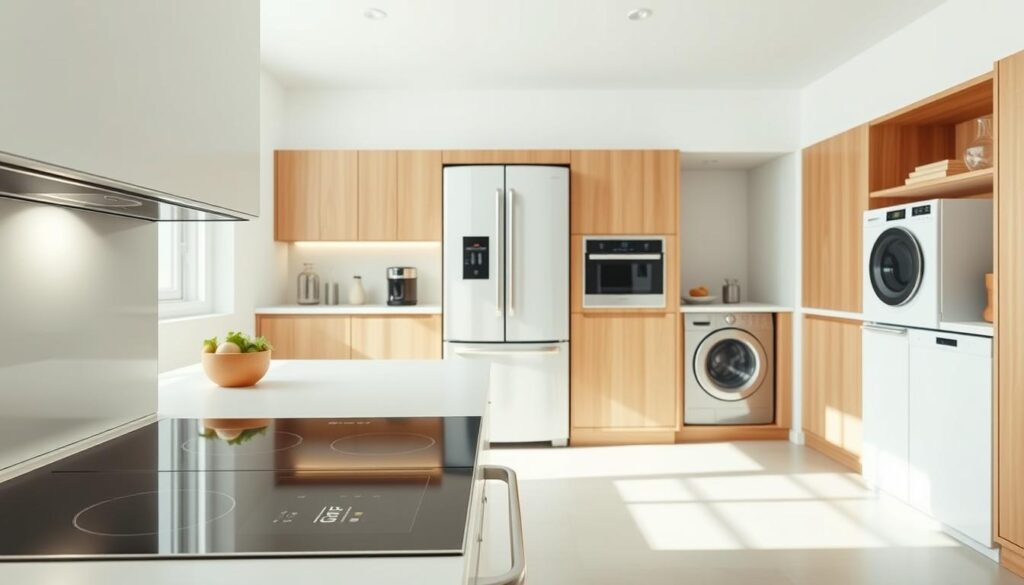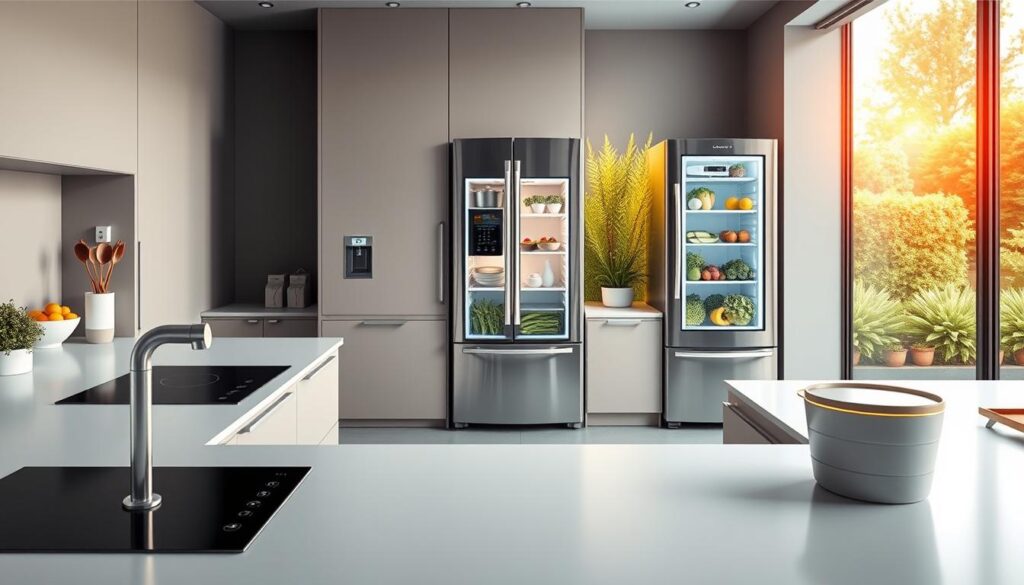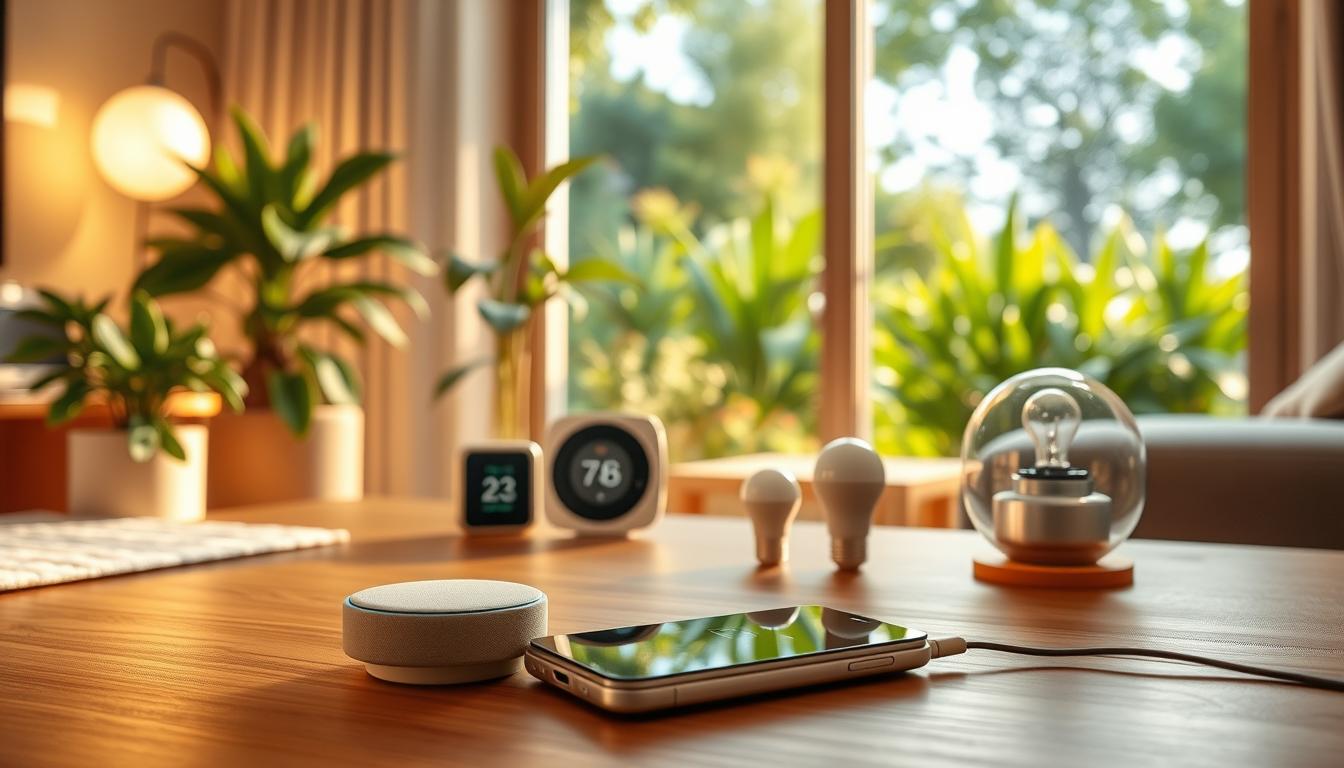Homeowners today are discovering how eco-friendly gadgets for home can transform everyday life. From smart thermostats to solar-powered chargers, these tools blend cutting-edge tech with planet-first design. Every device aims to reduce waste, save energy, and make sustainability effortless.
Why wait? Explore options that cut costs and shrink your carbon footprint. Whether you’re upgrading appliances or adding smart sensors, these innovations prove going green doesn’t mean sacrificing convenience.
Key Takeaways
- Eco-friendly gadgets for home merge tech with environmental care.
- Smart devices lower energy use and utility bills.
- Innovations like solar chargers and water savers are easy to install.
- These tools help households meet sustainability goals.
- Long-term savings and planetary benefits come hand-in-hand.
Introduction: The Rise of Eco-conscious Home Technology
Homeowners today are embracing sustainable living products to transform daily routines into planet-positive actions. From smart thermostats to solar-powered devices, eco-friendly tech is no longer a niche choice—it’s a mainstream shift reshaping how people live.
Understanding the Shift Toward Sustainability
Modern households prioritize reducing waste and energy use. Companies like Philips and LG now design appliances that cut carbon footprints. This shift isn’t just about gadgets—it’s a mindset shift toward valuing long-term environmental health over convenience alone.
How Eco-friendly Innovations Benefit Homeowners
- Cost savings: Energy-efficient devices slash electricity bills by up to 30%, according to 2023 U.S. Energy reports.
- Health boosts: Air-purifying systems and non-toxic materials improve indoor air quality, fostering healthier homes.
- Longevity: Well-made sustainable products often last longer than conventional options, reducing frequent replacements.
These changes reflect a growing demand for tech that aligns with values like responsibility and foresight. Whether through smart irrigation systems or solar panels, every choice builds a foundation for greener living.
The Innovation Behind Sustainable Living Products
Modern environmentally friendly home gadgets rely on cutting-edge engineering and design to reduce ecological footprints. Companies like Tesla and Philips lead the way, merging tech with sustainability. Solar-powered chargers, smart thermostats, and LED lighting systems now use renewable energy and intelligent sensors to optimize resource use.
- Tesla’s solar roof tiles blend energy generation with sleek aesthetics.
- Philips Hue lights adjust brightness using motion sensors, saving electricity.
- Ecobee thermostats learn user habits to cut heating costs by 20%.
Materials matter too. Brands like Grove Collaborative use bamboo and recycled plastics for kitchen tools, while ECOVATIVE designs packaging from mycelium—100% compostable. These choices slash waste without sacrificing durability.
“Innovation isn’t just about gadgets—it’s about rethinking materials and energy from start to finish.”
Smart sensors and AI in environmentally friendly home gadgets now predict usage patterns, ensuring efficiency. From water-saving showerheads by Nebia to Wi-Fi enabled recycling bins by TerraCycle, every product aims to simplify eco-friendly living. These advancements prove that tech and sustainability can—and must—go hand in hand.
Discovering Eco-friendly gadgets for home
From smart sensors to solar-powered essentials, modern green tech devices for household offer solutions that blend convenience with environmental care. These gadgets aren’t just trends—they’re practical tools reshaping how we live sustainably.
Key Features and Breakthroughs
Innovations like solar-powered outdoor lights or smart energy monitors highlight what sets these devices apart. Consider the EcoFlow RIVER Mini, a portable solar generator that charges gadgets without grid reliance. Or Bracel’s smart showerheads, which reduce water use by 40% without sacrificing pressure. These items combine cutting-edge tech with planet-friendly design.
- Self-adjusting modes: Sensors automatically optimize energy/water use.
- Long-lasting materials: Durable components cut down on waste.
- App integration
: Control devices via smartphone for real-time efficiency tracking.
Comparisons with Traditional Home Gadgets
Traditional appliances often lack the green tech devices for household’s smart adaptability. For instance, older thermostats run at fixed temperatures, while Nest Learning Thermostats learn routines to save 10-15% on heating/cooling costs. Similarly, basic lightbulbs use more watts than Philips Hue Smart LED bulbs, which last longer and slash electricity bills.
Here’s how they stack up:
- Energy use: Eco gadgets consume 30-50% less power.
- Cost: Initial prices may be higher, but long-term savings offset this.
- Impact: Reduced waste and carbon emissions align with global sustainability goals.
Choosing these devices isn’t just an upgrade—it’s a step toward a greener lifestyle without sacrificing comfort.
Integrating Green Tech Devices into Your Household
Adding eco-conscious home gadgets to your daily routine starts with small, smart choices. Begin by identifying high-usage areas like lighting or heating. For instance, swapping traditional bulbs with Philips Hue smart LEDs cuts energy use instantly. These devices connect to apps, letting you adjust settings from anywhere.
Pair gadgets with existing smart home systems like Amazon Alexa or Google Nest. Compatibility charts and manufacturer guides simplify setup. Start with a Nest Learning Thermostat to automate temperature control—saving energy without sacrificing comfort.
- Prioritize devices with Energy Star ratings for guaranteed efficiency
- Use voice commands to turn off appliances when not in use
- Sync solar panel data with energy monitors for real-time savings tracking
“Installing a smart sprinkler system cut my water bill by 30%. It’s intuitive and saves resources automatically,” says Sarah T., a Texas homeowner.
Involve family members in adopting habits like turning off voice assistants at night to reduce standby power drain. Eco-conscious home gadgets work best when integrated thoughtfully. Small changes like charging devices through solar-powered USB hubs add up to meaningful environmental impacts.
Regular updates to device software ensure peak performance. Many brands like Ecobee offer free firmware upgrades that enhance energy-saving algorithms over time. Every step toward green tech adoption creates a ripple effect—making sustainability a natural part of everyday life.
Energy Efficiency and Cost Savings with Eco-friendly Gadgets
Modern energy-efficient home technologies offer more than eco-friendly benefits—they deliver real savings. Upgrading to smart systems like programmable thermostats or solar-powered devices lowers energy waste and shrinks utility costs. Over time, these investments return value through reduced bills and a lighter environmental footprint.
Long-Term Savings on Utility Bills
Smart thermostats from brands like Nest or Ecobee learn routines and adjust temperatures automatically. Homeowners save 10–15% on heating/cooling costs annually. LED lighting from Philips or Cree consumes 75% less energy than traditional bulbs. Over five years, switching 20 bulbs could save $200–$300.
Environmental Impact and Reduced Carbon Footprint
Lower energy use means fewer greenhouse gases emitted by power plants. Solar panels or energy-efficient appliances reduce reliance on fossil fuels. A 2023 study by the U.S. Energy Information Administration shows homes using these technologies cut emissions by 30% on average. Small changes add up—like using Wi-Fi enabled plugs to stop standby power waste.
Cutting-edge Sustainable Home Appliances for Modern Living
Modern homes are adopting green living gadgets that merge technology with environmental care. Innovations like energy-efficient refrigerators and smart dishwashers redefine sustainability without sacrificing convenience. These appliances use advanced systems to reduce resource waste while keeping up with daily demands.
- Smart Refrigerators: Brands like LG and Bosch offer models with adaptive cooling and energy-saving modes.
- Water-Saving Dishwashers: Siemens and Whirlpool designs cut water use by 30% through precise spray tech.
- Eco-Wash Machines: Samsung’s AI-driven washers adjust cycles based on load size and fabric type.
“Smart appliances aren’t just gadgets—they’re tools for a greener lifestyle.” — Green Tech Innovators Report 2023

These appliances integrate sensors and AI to optimize performance. For instance, GE’s solar-powered dryer reduces grid reliance, aligning with green living gadgets goals. Homeowners see lower bills while supporting environmental health. The shift to such appliances shows that sustainability and modern living can thrive together.
Smart Home Innovations: Eco-conscious Devices for Everyday Use
Modern smart home technology now pairs cutting-edge features with ecological responsibility. Eco-friendly smart home devices merge voice commands, app controls, and simplified setups to make sustainable living intuitive and accessible.
Voice-Activated & App-Controlled Systems
Leading brands like Ecobee and Samsung offer voice-activated thermostats and lighting systems that respond to simple commands. Pair these with apps like Apple HomeKit or Google Home to adjust settings remotely.
- Control heating/cooling schedules via voice commands
- Track energy use through real-time app dashboards
- Automate appliance shutdowns to avoid waste
User-friendly Interfaces and Setup
No technical expertise is needed to install these systems. Philips Hue bulbs and August Smart Locks connect instantly via Wi-Fi, while Lutron Caseta switches adapt to existing wiring. Pre-loaded templates guide users through eco-mode settings, reducing setup time to minutes.
Many devices auto-adjust based on user habits—like Nest Learning Thermostats lowering heat when rooms are empty. This smart simplicity ensures homeowners save energy effortlessly without sacrificing comfort.
Future Trends in Eco-friendly Gadgets for Homeowners
Tomorrow’s sustainable home appliances promise even smarter, greener solutions. Innovators are focusing on AI-driven energy management systems that learn household habits to optimize resource use. Imagine fridges that adjust cooling based on food freshness or thermostats that sync with solar panels for peak efficiency.

- Biodegradable Materials: Brands like Bluesign Technologies are testing plant-based plastics for appliance casings that decompose safely.
- Solar-Powered Kitchens: Companies such as SunPower are developing stoves and ovens with built-in solar charging modules.
- Modular Design: Appliances like ModHouse’s dishwasher kits let users replace parts instead of buying new units entirely.
“The next five years will see sustainable home appliances become as common as smartphones,” says Dr. Lena Torres, a renewable energy analyst at Green Horizon Labs.
Smart sensors in washing machines from LG now detect fabric type and water hardness to cut cycles by 30%. Future models may even recycle rinse water for gardens. As tech evolves, expect partnerships between startups and giants like Siemens Home Appliances to accelerate adoption. These trends aren’t just eco-friendly—they’re reshaping how we live comfortably while protecting the planet.
Maintenance & Upkeep: Keeping Your Green Tech Running Smoothly
Regular upkeep keeps eco-friendly home innovations working at peak performance. Proper care ensures devices like smart thermostats or solar panels stay efficient for years. Start with these simple steps to maximize savings and reduce waste.
Regular Checks for Energy Efficiency
- Inspect filters in air purifiers or HVAC systems every three months. Clogged filters waste 15-30% more energy, says the EPA.
- Use smart apps like Nest or Philips Hue to track real-time energy usage. Adjust settings during off-peak hours to cut costs.
- Test solar panel angles twice a year. Proper tilt boosts energy capture by up to 20%, per SunPower studies.
Manufacturer Tips and Warranty Guidance
- Store manuals digitally. Most brands like LG ThinQ offer online portals for quick access to maintenance guides.
- Sign up for warranty alerts. Companies such as Ecobee send reminders for free tune-ups before issues arise.
- Avoid DIY repairs under warranty. Faulty fixes may void coverage. Contact certified technicians listed on brand websites.
Maintaining eco-friendly tech doesn’t need to be hard. Small steps like checking manuals or using app alerts turn upkeep into a breeze. With proper care, these innovations keep homes greener and wallets fuller for decades.
Case Studies: Real Homeowners Embracing Green Technology
Everyday homeowners are proving that eco-friendly gadgets aren’t just trends—they work. From solar panels to smart irrigation systems, real stories show how these tools transform homes. Let’s explore what happens when households commit to sustainable tech.
“Our solar panels saved over $1,200 last year on electricity. Plus, we love knowing we’re cutting emissions.” – Sarah, Colorado homeowner using LG Solar Solutions.
Success Stories and Testimonials
One family in California installed a Ecobee Smart Thermostat, reducing heating costs by 25%. Another household in Texas slashed water use by 30% with a Flume Water Monitor. These gadgets don’t just help the planet—they save money.
Lessons Learned and Best Practices
- Start small: Begin with affordable upgrades like LED bulbs before tackling bigger projects.
- Research brands: Look for ENERGY STAR® certified devices for guaranteed efficiency.
- Involve the whole household: Involving everyone ensures gadgets are used properly.
These examples show that sustainable tech isn’t complicated. Simple choices add up to big changes. Whether it’s a smart sprinkler system or a compost bin, every step counts toward a greener home.
Conclusion
Making your home greener starts with small steps that add up to big changes. Eco-friendly gadgets like Philips Hue smart bulbs or Nest thermostats prove sustainability and comfort go hand in hand. These innovations cut energy use, lower bills, and reduce your carbon footprint without sacrificing convenience.
Leading brands such as LG and Samsung now offer appliances designed for energy efficiency, proving eco-conscious choices are now standard in modern tech. Their smart washing machines and refrigerators use 40% less power than older models, aligning with federal energy guidelines.
Real users like those in Texas who installed solar-powered irrigation systems report saving $300 annually on water bills. Their stories show that investing in green tech isn’t just good for the planet—it’s practical and cost-effective.
Start exploring options today. Visit retailers like Best Buy or Home Depot to compare Energy Star-certified devices. Check manufacturer guides for setup tips to maximize savings. Every upgrade brings your household closer to a sustainable future.
Join the millions already reducing waste and energy use through smart home systems. Whether it’s upgrading to LED lighting or adopting water-saving fixtures, each choice builds toward a greener lifestyle. The tools are here—now it’s time to take action and embrace the future of sustainable living.
FAQ
What are some examples of eco-friendly gadgets for home use?
Great question! Some popular eco-friendly gadgets include smart thermostats like Nest, energy-efficient LED bulbs, water-saving showerheads, solar-powered chargers, and smart home devices from brands like Philips Hue that help manage energy consumption.
How do sustainable living products contribute to environmental conservation?
Sustainable living products help reduce waste, conserve energy, and lower carbon footprints through efficient usage. For example, energy-efficient appliances not only lower utility bills but also utilize less energy, which contributes to a reduction in greenhouse gas emissions.
Are there eco-friendly smart home devices that work with existing home systems?
Yes! Many eco-friendly smart devices are designed to integrate easily with existing home automation systems. Brands like Ecobee and August Smart Lock offer smart thermostats and door locks that can work seamlessly with platforms like Apple HomeKit, Google Assistant, and Amazon Alexa.
What are the long-term financial benefits of using energy-efficient home technologies?
Investing in energy-efficient home technologies can lead to significant long-term savings on utility bills. For instance, using smart thermostats to manage heating and cooling effectively can save homeowners up to 20% on energy costs. Additionally, energy-efficient appliances typically have a longer lifespan, resulting in less frequent replacement costs.
Do eco-friendly gadgets help in reducing my home’s overall carbon footprint?
Absolutely! Eco-friendly gadgets, such as energy-efficient appliances, solar panels, and smart home technologies, all contribute to reducing your home’s carbon footprint by promoting energy efficiency and utilizing renewable resources. The cumulative effect of these devices can lead to a substantial reduction in greenhouse gas emissions.
How can I maintain my eco-friendly gadgets to ensure they function efficiently?
Regular maintenance is key! For example, ensure that filters on energy-efficient appliances are clean, perform energy efficiency audits on gadgets like smart thermostats, and follow the manufacturer’s suggested maintenance schedules. This helps prolong their lifespan and ensures they continue to operate at peak efficiency.
